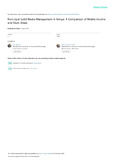| dc.contributor.author | Waweru, Samuel | |
| dc.contributor.author | Kanda, Edwin | |
| dc.date.accessioned | 2018-08-28T15:30:28Z | |
| dc.date.available | 2018-08-28T15:30:28Z | |
| dc.date.issued | 2012-07-20 | |
| dc.identifier.uri | http://r-library.mmust.ac.ke/123456789/697 | |
| dc.description.abstract | Municipal Solid Waste Management is one of the most crucial environmental health problems facing African cities. Kenyan urban population has been growing rapidly over the last decade. Consequently, generation of solid, liquid and gaseous wastes has been increasing at the same tremendously due to increased population and industrial development. The amount of solid waste generated is expected to increase as the country strives to be a middle income country by 2030.
The increased population in urban areas coupled with slow expansion of the economy has led to increase in slums and hence compounding the problem of solid wastes. This paper gives an overview of solid waste management in Kenya by comparing the solid waste situation in middle income estate of Langata and a low income area of Kibera slums. Although the solid waste composition is similar in terms of the fractional components, the overall solid waste management is different in both areas with Langata having a good solid waste collection system compared to the improvised Kibera. Kibera is characterized by unregulated disposal of refuse, thereby
courting serious environmental disasters and health risks to the residents. | en_US |
| dc.language.iso | en | en_US |
| dc.publisher | CDMHA/ADMCRK | en_US |
| dc.subject | solid wastes, solid waste management, environmental disaster, slums and middle income area | en_US |
| dc.title | Municipal Solid Waste Management in Kenya: A Comparison of Middle Income and Slum Areas | en_US |
| dc.type | Presentation | en_US |

